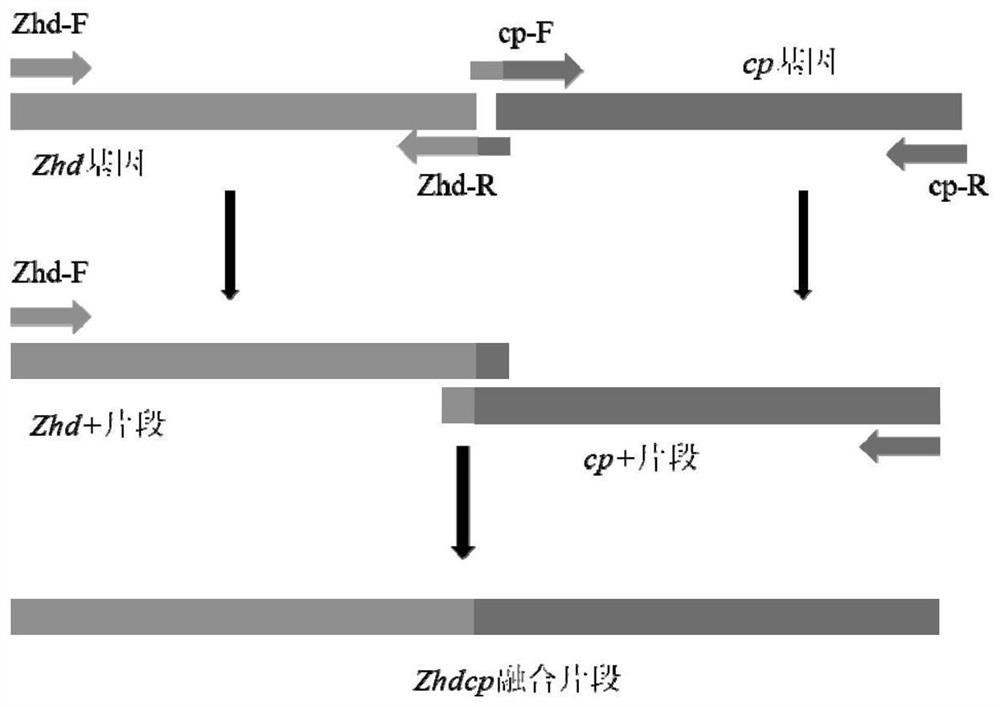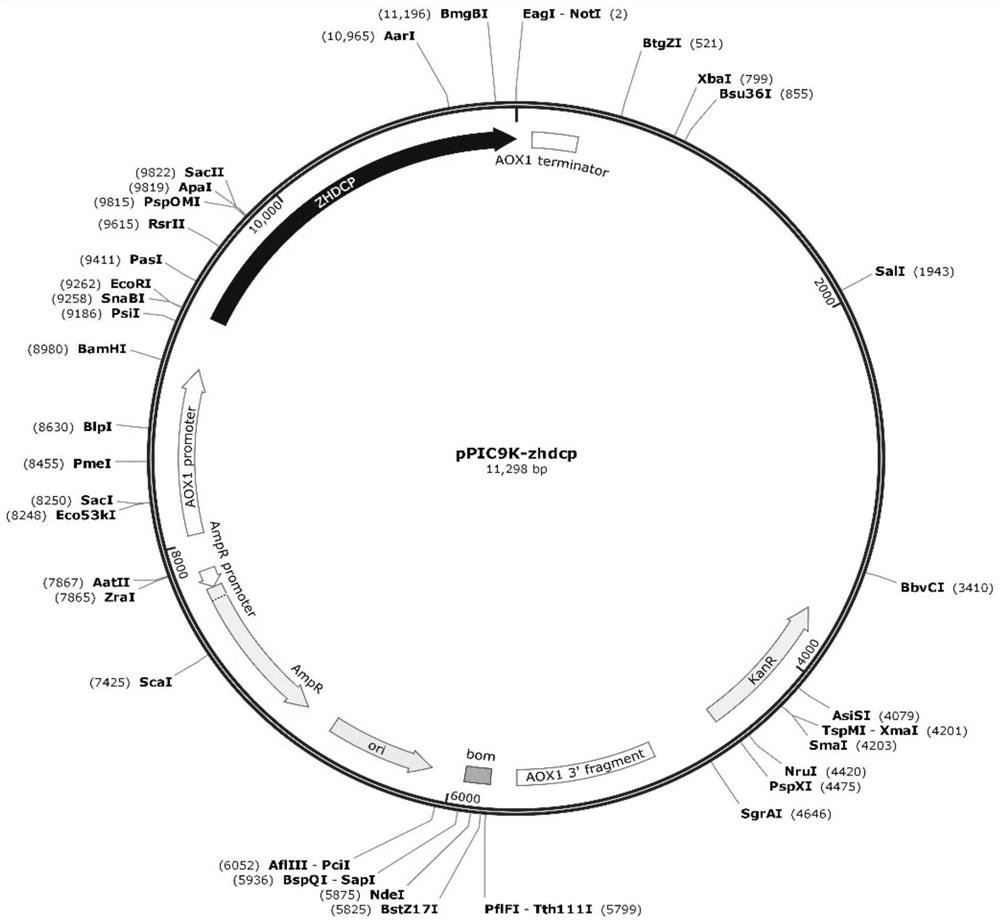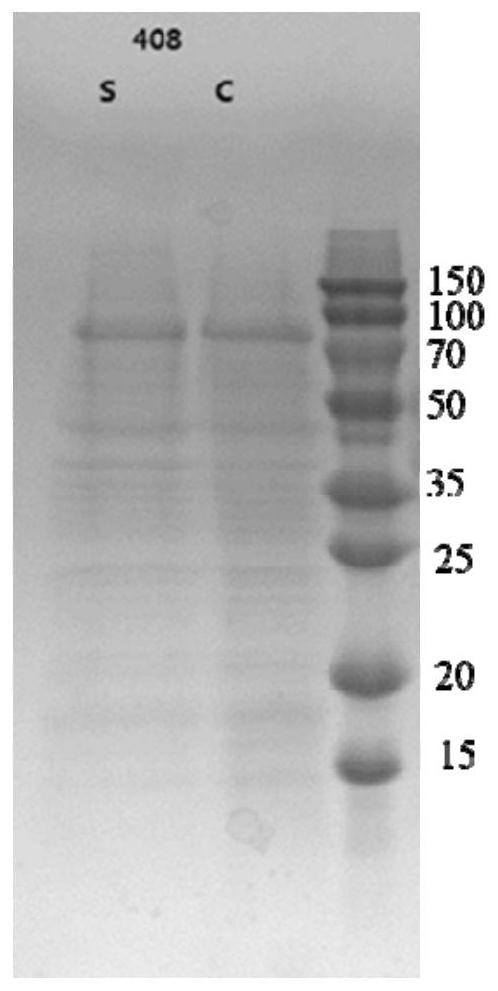Multifunctional enzyme for degrading mycotoxin and its application
A mycotoxin and hydrolase technology, applied in the fields of genetic engineering and enzyme engineering, can solve the problems of toxic joint action and strong toxicity
- Summary
- Abstract
- Description
- Claims
- Application Information
AI Technical Summary
Problems solved by technology
Method used
Image
Examples
Embodiment 1
[0116] Example 1. Construction and transformation of ZHDCP encoding gene cloning and eukaryotic expression vector
[0117] 1. Cloning of ZHDCP-encoding gene
[0118] The zhd and cp gene sequences are shown in SEQ ID NO:1 and SEQ ID NO:3, respectively. In order to optimize the expression, the inventors conducted repeated experiments and designed codon-optimized sequences as shown in SEQ ID NO: 2 and SEQ ID NO: 4, respectively.
[0119] Further, in order to optimize the expression, the inventors modified the coding sequence of the CP protein, and truncated the coding sequence coding for amino acids 2-31 of the N-terminal of the CP protein. At the same time, in order to avoid the premature end of coding, the terminator TAA of the zhd coding gene was removed.
[0120] Using optimized zhd and cp as amplification templates, high-fidelity enzyme The target gene fragment was amplified by Max DNA Polymerase (purchased from Takara, Japan).
[0121] The amplification primers for Zhd...
Embodiment 2
[0133] Example 2. ZHDCP enzyme protein fermentation
[0134] 1. Preparation for Fermentation (Day 1)
[0135] Seed medium: 200mL YPD medium
[0136] Glycerol feed medium: 200 mL of 50% glycerol
[0137] Defoamers (polyethers)
[0138] Fermentation broth: 2L BMGY medium
[0139] Add 500 μl of antifoaming agent dropwise to the fermentation broth and pour it into the tank together for off-site sterilization. Calibrate the pH electrode before sterilization. After sterilization, connect the electrodes and pipelines, adjust the dissolved oxygen to zero, add 4mL of 500X biotin and 200mL of 10XYNB when the temperature is lowered to 30°C, adjust the speed to 50rpm, and adjust the air flowmeter to 2L / min overnight.
[0140] The seed solution was cultured at 16:30, and a single colony was picked and cultured in a 50 mL bottle of YPD medium (4 bottles in total) on a shaker at 28°C and 200 rpm.
[0141] 2. Fermentation on the tank (the next day)
[0142] 1. Initial Glycerol Culture ...
Embodiment 3
[0151] Example 3. Degradation of ZEN by recombinase ZHDCP
[0152] Experimental group: add 15μg ZEN and 5μg recombinase ZHDCP to a 1.5mL EP tube, dilute to 1mL with buffer (Tris-HCl buffer, containing 150mmol / L NaCl: 25mmol / L, pH=7.0), shake and mix well .
[0153] Control group: add 15 μg ZEN to a 1.5 mL EP tube, dilute to 1 mL with buffer (Tris-HCl buffer, containing 150 mmol / L NaCl: 25 mmol / L, pH=7.0), shake and mix well.
[0154] The control group and the experimental group were placed in a water bath at 35°C for 2 hours. After the reaction was completed, the centrifuge tube was placed in a water bath at 98°C for 2 minutes to inactivate, taken out and cooled to room temperature, and filtered with a water-based filter membrane.
[0155] The standard curve was prepared with first-grade water in the control group, and the standard concentration was 20, 50, 100, 200, and 500 ng / mL. The solution in the experimental group was appropriately diluted with first-grade water, and ZE...
PUM
 Login to View More
Login to View More Abstract
Description
Claims
Application Information
 Login to View More
Login to View More - R&D
- Intellectual Property
- Life Sciences
- Materials
- Tech Scout
- Unparalleled Data Quality
- Higher Quality Content
- 60% Fewer Hallucinations
Browse by: Latest US Patents, China's latest patents, Technical Efficacy Thesaurus, Application Domain, Technology Topic, Popular Technical Reports.
© 2025 PatSnap. All rights reserved.Legal|Privacy policy|Modern Slavery Act Transparency Statement|Sitemap|About US| Contact US: help@patsnap.com



